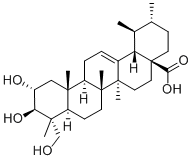Uses
wound healing, experimental carcinogen
Uses
Asiatic Acid is a terpenoid with an ursane skeleton isolated from Centella asiatica. Asiatic Acid is a neuroprotectant and induces of apoptosis in HepG2 human hepatoma cells.
Uses
Asiatic acid is commonly used in wound healing. Asiatic acid has antioxidant, anti-inflammatory and neuroprotective properties. It is a starting material for asiatic acid derivative synthesis for use as anticancer agents, glycogen phosphorylase inhibitors and and hepatoprotectants.
Definition
ChEBI: A pentacyclic triterpenoid that is ursane substituted by a carboxy group at position 28 and hydroxy groups at positions 2, 3 and 23 (the 2alpha,3beta stereoisomer). It is isolated from Symplocos lancifolia and
Vateria indica and exhibits anti-angiogenic activity.
General Description
Asiatic acid is a naturally occurring pentacyclic triterpenoid, obtained from
Centella asiatica.
Biochem/physiol Actions
Asiatic acid is commonly used in wound healing. Asiatic acid has antioxidant, anti-inflammatory and neuroprotective properties.
target
TNF-α | IFN-γ | IL Receptor | Caspase | p21 | NOS | NADPH-oxidase | NO | HMG-CoA reductase | COX




